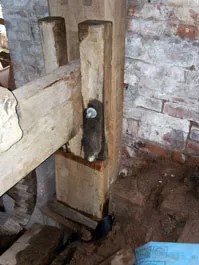Best viewed in landscape
Watermill Blog - Dry Rot
10th April 2008
There was a bit of a buzz amongst the team today. We are beginning to realise that we should soon be able to turn the machinery under water power!
As regular readers of this watermill blog will remember, the internal gears have been disengaged from the waterwheel for many months but we are now planning to put them back in gear.

The completed job that has given us the buzz can be seen in the picture. We have finished the repair to the hurst post and repaired the old repair.
We have put the hurst cross beam back in place, as you can see, and the whole thing is looking much more like it should.
We are not quite ready to put everything back though. The ground beam that carries the inner hurst posts has been badly attacked by dry rot and needs repairing.
Fortunately this will not present the same level of difficulty as the vertical post and we had made good progress with the job by the end of the day. A suitable piece of timber had been identified and the cleaning up was well under way.
It always seems perverse that damp causes dry rot but that's the way it is. Effected timber takes on the cracked appearance of dried mud due to the action of a fungus that thrives in damp wood. It is hard to think of a damper place than the basement of a watermill and it is surprising that we don't have even more problems with dry rot than we actually have.
Maybe, just maybe, we will be able to demonstrate some turning machinery when the first hillclimb event takes place on the first weekend in May (have a look at the MAC site) which gives us a target to aim for.
The hurst work was being done by Martyn, Colin and Richard but Richard left shortly after lunch for domestic duties.
Max also left early after spending most of the day working on the top floor of the mill, putting the finishing touches to the sack hoist windlass and fixing more hop sacks in place as roof lining.
Dick painted the components of the PTO shaft including the one section of shaft that is in the workshop. The universal joint assembly that joins the two sections of shaft doesn't look any less crude now it has a coat of paint.
Jonathan worked on the repairs to the north wall of the stable block. As well as the holes in the brickwork, now mostly repaired, the whole wall needs re-pointing. Some of the mortar joints have already been raked out, which is a help, but it is still an enormous task.
This is typical of the sort of job that can be done very cheaply with volunteer labour, with relatively little material content but a lot of time. This watermill blog is made up of many such tasks.
Go to the next Watermill Blog entry
Go to the previous Watermill Blog entry
Learn how to Support Us
Return to our Home Page